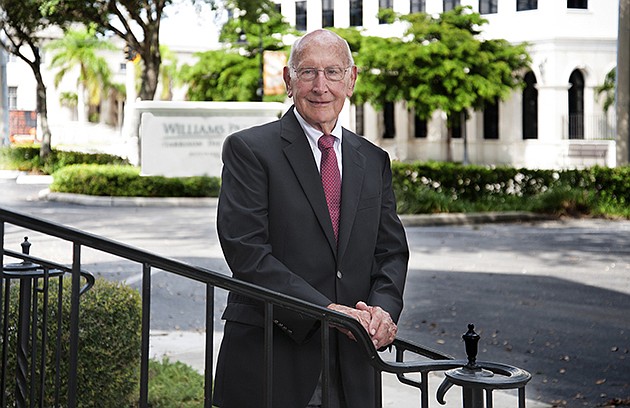- July 26, 2024
-
-
Loading

Loading

Attorneys at Perry & Williams, one of the first law firms in the Sarasota-Bradenton region, were at a business crossroads in the decade after World War II: They could go after high-volume work, including insurance defense and criminal cases. Or they could stick to core practice areas such as banking and real estate.
One half of the firm, Sydney Perry, left and went high-volume. But J.J. Williams and several partners, including W. Davis Parker and young attorney William Harrison, stuck to the original mission of the firm. That strategy was a slow struggle, at first. “When we separated from high-volume litigation business it restricted the clients we had” or could get, says Harrison, still practicing 60 years later.
That firm, with a client list that included circus icon John Ringling, became Williams Parker Harrison Dietz, for fellow partner George Dietz. William Getzen joined the team a few years later and became the fifth named partner. Known locally as Williams Parker, the firm celebrates its 90th anniversary in 2015 — a feat of stability exceedingly rare for mid-size, independently run law firms.
Here are details behind four key decisions attorneys say helped define the current practice over the last 90 years:
Locations: The first key move, says Harrison, was to get out of the Palmer Bank Building in downtown Sarasota. The firm had been a charter tenant there, on the seventh floor, from 1928 until 1957. But the space was too small, and there was a bigger problem: There was only one elevator, which was operated by the landlord and only during business hours.
Harrison recalls many tiring climbs up to the office at nights and on weekends.
The firm moved to a bigger space on State Street. A decision to build a building, at Ringling Boulevard and Orange Avenue downtown, came in 1969. That complex remains the firm's headquarters, with an additional wing built in 1991. There's ground floor parking and offices.
Also important, says Williams Parker attorney Mike Hartenstine, who joined the practice in 1977, is the firm's shareholders are co-owners of the building, not tenants. That provides stability. “Even though that's not a favored strategy of law firm consultants, I think it's provided a sense of collegiality for our firm,” says Hartenstine.
Quality over quantity: The firm, Harrison says, wanted to become known for its work, not its size. Over the years, say firm leaders, that's helped foster a family-like atmosphere, where quality of life isn't compromised by work demands like it can be at other firms that chase billable hours quotas. “When candidates come in to interview, they get that right away,” says Williams Parker tax, corporate and business law attorney Michael Wilson.
Specialization: The decision to recruit tax and corporate attorneys in the 1980s led to diversity in the firm's disciplines. That helps during market downturns.
Central committee: The firm ran on a decentralized management structure up until 1996. According to Hartenstine, that translated to a “confederation of lawyers pursuing their individually perceived goals.”
The firm instituted a three-member management committee to shake that up. That committee makes most of the significant decisions for the practice today, instead of a straight up vote for each partner. “Prior to 1996, we confused collegiality with democracy,” Hartenstine says in an email. “Collegiality is the way we act toward, care about and respect one another. Democracy is the way we have a say in how the firm is administered.”
There were many other key decisions at the firm over the years, including remaining independent. But for Harrison, the firm's longest-standing active attorney, any decision that led to good work opposite growth for growth's sake was a good one. “This is a place where we can practice real high-quality law,” says Harrison. “And it's not a sweat shop.”
By the numbers
Williams Parker
8 - Sarasota County Bar Association presidents. (Three attorneys have been president of the association's young lawyers division.)
1- At least one Williams Parker attorney was born in every decade from 1920 to 1980.
34 - Attorneys who scored the highest rank, AV rated, on Martindale-Hubbell. (Firm has 42 total lawyers.)
19 - Attorneys certified by the Florida Bar in one or more of these specialties: real estate; wills, trusts and estates; health law; employment law; appellate law; and tax law.
10 - Attorneys with an LL.M in taxation, earned by a fourth year of law school.
5 - Attorneys who are CPAs.
4 - Attorneys with an M.B.A.
4 - Attorneys with a master's in accounting.
Source: Williams Parker
Follow Mark Gordon on Twitter @markigordon